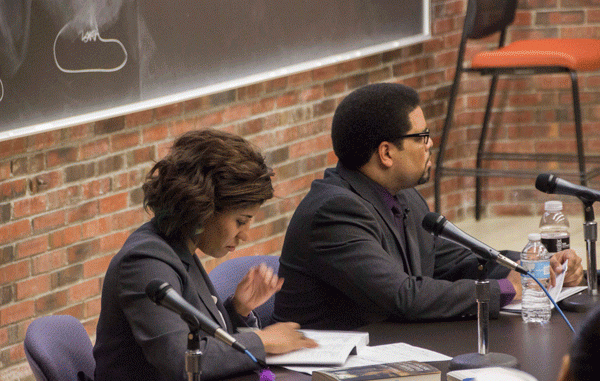
While many claim this country is in a post-racial period, the economics of modern American wealth would beg to differ.
On Thursday, March 31, Darrick Hamilton, Ph.D., an associate professor of economics and urban policy at the New School, held a lecture entitled, “Rhetoric vs. Reality: Neoliberal Thought and the Racial Wealth Gap.” Speaking before a crowded Lecture Center, Hamilton analyzed the effects of institutional racism and how the Great Recession affected minority communities. Cruz Bueno, Ph.D., a visiting professor to the Black Studies Department, provided additional commentary. The lecture was sponsored by the economics department and co-sponsored by the political science and international relations, geography and Black Studies Departments.
The lecture centered on how the widening income inequality gap has been felt even more so by minorities than whites. Hamilton, the president-elect of the National Economic Club, spoke about how the correlation between wealth and satisfaction can be used to evaluate the economic status of minority communities.
“What better economic indicator than wealth?” Hamilton asked. “Wealth provides security, agency and choice in life. It provides human capabilities with economic development.”
According to Hamilton, the top .1 percent of wealth earners own almost 23 percent of the wealth in America, which he claimed was not a new phenomenon. Hamilton praised Sen. Bernie Sanders for raising the issue of income inequality in the presidential election cycle.
“The wealth gap is even more pronounced by race,” Hamilton said.
Blacks and Latinos make six cents and seven cents, respectively, compared to every dollar made by their white counterparts. Hamilton also provided statistical evidence that black college graduates still make less than whites who don’t graduate high school.
Hamilton admonished the legacy of efforts to address poverty in the African American community by focusing policy on the black family structure rather than on institutional racism. From Hamilton’s perspective, such suggestions seek to put blame on blacks for their plight rather than on the factors that entrap them in poverty. Between high incarceration and unemployment rates, coupled with predatory payday loans that act as a debt trap, Hamilton argued that African Americans are faced with a narrow path to prosperity.
“The rhetoric says that we’re post-racial and that blacks have to ‘get over it,’” Hamilton said. “But that mindset has hurt black advancement. The wealth position of many communities of color still remains unclear.”
Hamilton was even critical of President Barack Obama stating that he perpetuated an unfair expectation of African Americans and did not fully grasp the Black Lives Matter movement. Hamilton said that at worst, Obama misunderstands the Black Lives Matter movement or “is trying to co-opt it.”
Hamilton was equally as critical of Obama’s “My Brother’s Keeper” initiative, saying it ignores the issues faced by African American women. Both Oprah Winfrey and Obama were highlighted as society’s exceptions to the rule, serving as powerful African American figures in finance and politics. Hamilton suggested that the emphasis should be on encouraging education and equal opportunity for young African Americans to achieve those levels of authority.
To conclude his lecture, Hamilton suggested a stratification economic method entitled, “Baby Bond Program.” The measure, termed “Social Security for life,” would cost $80 billion and account for two percent of current federal expenditures. The goal of such a program would be to “break the link between race, inheritance and economic advantage,” basing the race neutral reparations on the family wealth at birth.
“We overexaggerate the value of education,” Hamilton said. “But the racial gap is structural, not behavioral. Stratification acknowledges the conscious role of discrimination and goes beyond the individual, analyzing inter-group disparities.”
